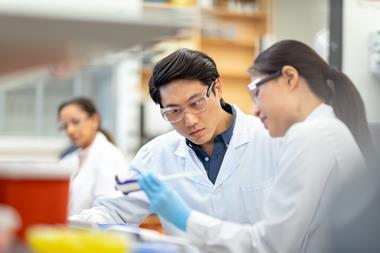Beauty is in the eye of Procter and Gamble's skincare team, reports Manisha Lalloo
Beauty is in the eye of Procter and Gamble’s skincare team, reports Manisha Lalloo
At Procter and Gamble (P&G), skincare is big business. With 11 technical beauty centres around the world, and brands including Olay, Gillette and Braun, career opportunities for chemists are vast. In Europe, the skincare team is based at the London Innovation Centre in Egham, UK, and encompasses everything from traditional R&D through to scientific communications.
Skincare at P&G is a high-tech area. ’It’s constantly changing, the technologies are constantly advancing,’ says Belinda Paine, a skincare technologist in the analytical department at Egham.

If P&G doesn’t have expertise in a particular area, it can be sourced from academia. For example, says Paine, they collaborated with Leicester University, where DNA fingerprinting was pioneered, before investigating DNA protecting skin creams.
Paine has been at P&G for the past two years after completing a PhD at Bath University and working in industry for a year. She is particularly impressed by the level of support, opportunities and wide range of expertise within the company. ’Every day when I come in I’m always inspired because everybody is so passionate about what they’re doing.’
One such expert within the skincare team is Jonathan Crowther, who joined the company in 2000. As a senior scientist, his strong analytical background has led him to develop new methodologies for looking at skin as well as designing and running clinical studies to prove what P&G products actually do.
’I’m a scientist through and through,’ he says. ’If I’m going to be able to say something I have to be able to prove it. Any changes our products cause have to be seen, recorded and quantified.’
As a specialist on methods and claims, Crowther does not have his own project team but works alongside the clinical testing facility and groups in order to design and execute studies for the project teams as and when they are needed.
’In classical skincare we have a number of techniques which look at different aspects of the skin. But since the acquisition of Gillette we’ve moved into areas that weren’t traditionally assessed with skincare methods, such as hair removal,’ says Crowther. ’I do a lot of work to define new methods and to make old methods capable of looking at the impacts of these hair removal techniques on the skin.’
Communicating the science
Crowther’s enthusiasm for the job is clear. ’Working in an industrial environment provides fresh challenges on a daily basis. If you’re up for a challenge, it’s definitely something I would recommend to anybody.’
Sian Morris, a scientific communications manager for the skincare team, has been working at P&G since 1992. Her roles at the company have included working as a formulation chemist as well as in process engineering and consumer understanding. Today Morris works to find ways to communicate the science behind P&G products.
’My role is to bring together messages about the technology in a way that’s relevant to different groups,’ she says. ’It could be a beauty journalist working for a magazine, a science journalist working for The Times or a professor of dermatology in the US.’
Although it is possible to join the communications team with a science degree and a talent for communicating, Morris feels her hands-on experience has given her a good grounding for her current job. ’I’ve had quite a varied career, and in the last couple of years I’ve been able to take all of that knowledge, into this different world where I spend a lot of time talking to people externally.’
P&G is passionate about including scientists in every aspect of product design, from inception right through to promotion. Worldwide, P&G Beauty employs 1800 scientists. ’We have a principle at P&G that in order to get the most out of our products we need to get scientists to talk directly to women about what they want and what’s possible to achieve,’ says Morris. Between this and the way the company draws on techniques from the latest research such as genomics, what appears to be a simple cream may have taken up to five years to design.
’Working in a cosmetics area there is sometimes a perception by the public and also by academics and dermatologists that it’s not a heavy science,’ says Crowther. ’People often say "It’s a moisturiser, how difficult can it be?" It’s not quite like that!’
Manisha Lalloo is a freelance science writer based in London, UK












No comments yet